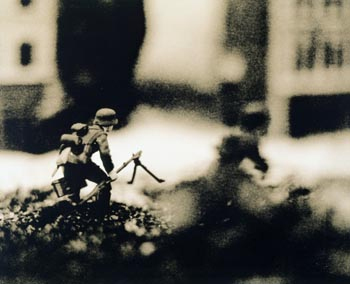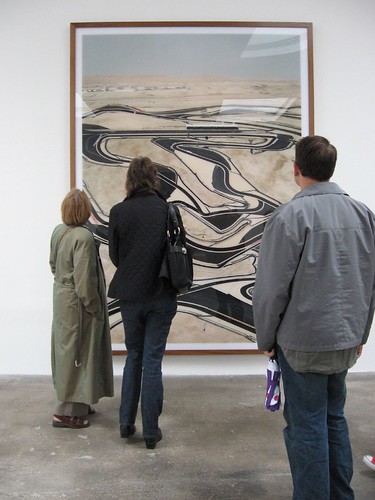This photograph of Whitehall from Trafalgar Square, taken by M. de St. Croix in 1839, is probably the earliest surviving photograph of London, and certainly one of the first photographs taken in England.
Take a magnifying glass and study it from corner to corner – what can you see? A ghost like coach? A figure near the statue?
Depth of Field - Technical Information
All Cameras have an Aperture.
An Aperture is the hole that lets light into the camera.
The Pinhole in your pinhole camera is your aperture.
On your SLR the Aperture is just a more sophisticated version of the pinhole – but you can make it larger or smaller.

This image of toy soldiers by David Levinthal uses the blur created by a Minimum Depth of Field. This gives the artificial scene a strange atmosphere.
An Aperture is the hole that lets light into the camera.
The Pinhole in your pinhole camera is your aperture.
On your SLR the Aperture is just a more sophisticated version of the pinhole – but you can make it larger or smaller.

- The size of the aperture affects your final image.
- A large Aperture means One thing is in Focus (e.g.. f/2) - Minimum Depth of Field
This image of toy soldiers by David Levinthal uses the blur created by a Minimum Depth of Field. This gives the artificial scene a strange atmosphere.
- A small Aperture means Everything is in Focus (e.g. f/22) - Maximum Depth of Field
Winston O. Link has used a maximum Depth of Field to capture this classic image from 1956. We can clearly see the couple at the front, the train speeding past and the movie being projected onto the screen in the distance.
Maximum Depth of Field - References
Andreas Gursky is a photographer who uses a Maximum Depth of Field (small hole). Gursky was taught by The Bechers. His images are on a large scale when they are displayed on the gallery wall.
This allows the image to be explored from corner to corner – because the image has a lot of depth. The objects closest to the camera lens are as sharp as the objects furthest away.
Gursky often photographs large landscapes where people appear like ants. This is a characteristic of The Sublime in art – were people appear dwarfed by nature. Like the feeling you get when you stare out at sea or up at the stars and you feel small in comparison – this is the sublime. Often images that use a maximum depth of field have a cold, distant, objective quality.
This is the middle section of 'The Garden of Earthly Delights' a triptych that depicts the garden of eden, heaven and hell. It is by Hieronymus Bosch who was a 15th century painter from northern Europe.
We don't see the world as one large pin sharp image. We see lots of fragments of the world - a corner of a table, a hand, a lamp - and then our minds piece this information together to create the world (closer to a minimum depth of field photograph or a cubist painting).
Pre-Modern Paintings and maximum Depth of field Photographs show us an abstracted view of the world where everything is in focus. This image by Bosch can be explored like a Gursky photograph - from corner to corner - It has the look of the camera’s unforgiving objective eye.
Ansel Adams was a giant of 20th century photography. He was a founding member of The f64 Group. F64 refers to their use of a very small aperture – creating very detailed and objective maximum depth of field shots. A tripod would have been used to create these shots as the small aperture means a slower shutter speed is needed.
Adams images are full of detail. An ephemeral cloud formation becomes a permanent structure in his above image.
In the above image Adams creates this iconic image of the never-ending road that seems to stand for the vastness of the American landscape – and the American Dream. The history of the pilgrims, making their journey from the East coast to the West, seems wrapped up in this image and the myth of America.
Bill Brandt created a varied series of work throughout his life from Portraits, Social Documentary (see Mass Observation) to strange surreal images.
Rene Magritte was a surrealist painter and his images share qualities with this series from Brandt. The Surrealists were interested in the world of the unconscious and dreams. In dreams the everyday mixes and creates strange juxtapositions.
Most of us have seen rain and we have seen men in suites (Magritte used these figures as short hand for the bourgeois) – they are fairly everyday. In dreams our it could rain business men - as in this above painting by Magritte. These are the kind of Juxtapositions the Surrealists like to play with.
Above is a portrait of Magritte by Brandt that incorporates elements of both artists work.
Bill Brandt created a varied series of work throughout his life from Portraits, Social Documentary (see Mass Observation) to strange surreal images.
In these above images Brandt has used a maximum depth of field to create Surreal images. He has played with foreshortening to place an ear on the same visual plane as a Sussex beach. In these images fingers become rocks and Brandt reflects himself in a mirror.
Most of us have seen rain and we have seen men in suites (Magritte used these figures as short hand for the bourgeois) – they are fairly everyday. In dreams our it could rain business men - as in this above painting by Magritte. These are the kind of Juxtapositions the Surrealists like to play with.
Above is a portrait of Magritte by Brandt that incorporates elements of both artists work.
We can see depth of field used all the time in cinema. A film camera follows the same rules a normal camera and so many of the same principles apply. Often a minimum depth of field is referred to as 'shallow focus' and maximum depth of field is referred to as 'deep focus'.
In this scene from Orson Welles' 'Citizen Kane' you can clearly see how Welles has used deep focus. This has allowed the viewer to see three figures clearly - the closest figure on the left, the figure on the right and, in the centre, a figure in the doorway. The scene also uses The Rule of Thirds - the figure on the left dominates the left-hand third, the middle third is empty (bar the distant doorway with a shadowy figure) and the right-hand third has another character.
Once you start looking at different scenes from 'Citizen Kane' you can see how Welles (and his cinematographer Gregg Toland) used deep focus (Maximum Depth of Field) with the rule of thirds. The stark black and white emphasise the structure behind each scene. For more references click the Pinterest icon below.


















